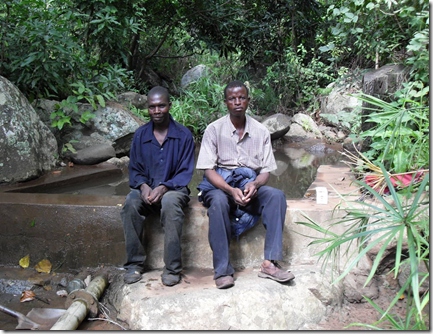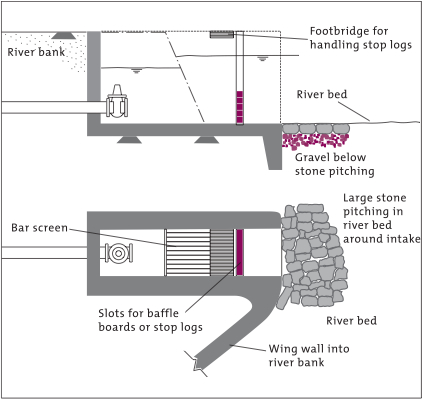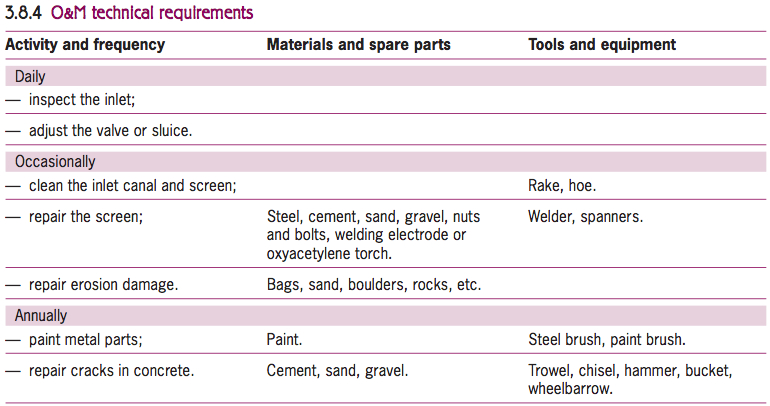Difference between revisions of "Water Portal / Rainwater Harvesting / Surface water / Protected side intake"
(→Acknowledgements) |
(→Acknowledgements) |
||
| (24 intermediate revisions by the same user not shown) | |||
| Line 1: | Line 1: | ||
| − | + | {{Language-box|english_link= Water Portal / Rainwater Harvesting / Surface water / Protected side intake | french_link= Prise d'eau latérale protégée | spanish_link= Captación de Toma Lateral | hindi_link= वाटर पोर्टल / वर्षाजल संचयन / सतही जल / संरक्षित तटीय जलग्रहण | malayalam_link= Coming soon | tamil_link= Coming soon | korean_link= Coming soon | chinese_link=受保护的引水口 | indonesian_link= Asupan Tepi yang Terlindungi | japanese_link= 保護された横取り取水口 }} | |
| − | |||
| − | A protected side intake provides a stable place in the bank of a river or lake, from where water can flow into a channel or enter the suction pipe of a pump. It is built to withstand damage by floods and to minimize problems caused by sediment. Side intakes are sturdy structures, usually made of reinforced concrete, and may have valves or sluices to flush any sediment that might settle. Often, a protected side intake is combined with a weir in the river to keep the water at the required level, a sand trap to let the sand settle, and a spillway to release excess water. The river water may enter the side intake through a screen, and a spillway overflow may be provided. Sometimes, protected side intakes are combined with a dam and a flushing sluice, which allows the upstream part of the river to be flushed. | + | [[Image:intake icon.png|right|80px]] |
| + | [[Image:AriverIntake.png|thumb|right|200px|A river intake on the Sankhulani scheme, shown with Mr. Alizeo (repair team member) and Mr. Utumbe (government water supervisor). Photo: [http://thoughtsfrommalawi.blogspot.com/2009/08/how-it-works.html Thoughts from Malawi blog.]]] | ||
| + | __NOTOC__ <small-title /> | ||
| + | A '''protected side intake''' provides a stable place in the bank of a river or lake, from where water can flow into a channel or enter the suction pipe of a pump. It is built to withstand damage by floods and to minimize problems caused by sediment. Side intakes are sturdy structures, usually made of reinforced concrete, and may have valves or sluices to flush any sediment that might settle. Often, a protected side intake is combined with a weir in the river to keep the water at the required level, a sand trap to let the sand settle, and a spillway to release excess water. The river water may enter the side intake through a screen, and a spillway overflow may be provided. Sometimes, protected side intakes are combined with a dam and a flushing sluice, which allows the upstream part of the river to be flushed. | ||
| − | ==Suitable conditions== | + | ===Suitable conditions=== |
* The main purpose of an intake is to ensure a constant water supply that can be adjusted to suit local conditions. | * The main purpose of an intake is to ensure a constant water supply that can be adjusted to suit local conditions. | ||
* Avoid large rivers with a fluctuating water level. Be very careful to make sure the intake is not set above the minimum water level of the river. | * Avoid large rivers with a fluctuating water level. Be very careful to make sure the intake is not set above the minimum water level of the river. | ||
| − | ==Resilience to changes in the environment== | + | ===Resilience to changes in the environment=== |
====Drought effects on cement==== | ====Drought effects on cement==== | ||
| − | '''Effects of drought''': | + | '''Effects of drought''': When water levels are low, problems can occur if the concrete was badly made, which also leads to cracked linings (e.g. in tanks, dams, waterways, wells, and other structures). |
'''Underlying causes of effects''': Less water used for curing; Impure water used for mixing. <br> | '''Underlying causes of effects''': Less water used for curing; Impure water used for mixing. <br> | ||
| Line 19: | Line 21: | ||
More information on managing drought: [[Resilient WASH systems in drought-prone areas]]. | More information on managing drought: [[Resilient WASH systems in drought-prone areas]]. | ||
| − | ==Construction, operations and maintenance== | + | ===Construction, operations and maintenance=== |
| − | [[Image:protectedSideIntake.jpg|thumb|right| | + | [[Image:protectedSideIntake.jpg|thumb|right|200px|Protected side intake diagram. Click to zoom. <br> Drawing: WHO.]] |
— Operation of a protected side-intake system is usually carried out by a caretaker; <br> | — Operation of a protected side-intake system is usually carried out by a caretaker; <br> | ||
— a valve or a sluice may have to be adjusted daily, the inlet to the channel or pump checked for obstructing debris, and any damage repaired; <br> | — a valve or a sluice may have to be adjusted daily, the inlet to the channel or pump checked for obstructing debris, and any damage repaired; <br> | ||
| Line 31: | Line 33: | ||
— after flooding, cleaning may be necessary. | — after flooding, cleaning may be necessary. | ||
| − | Brikke and Bredero, in their publication ''[ | + | Brikke and Bredero, in their publication ''[http://www.washdoc.info/docsearch/title/117705 Linking technology choice with operation and maintenance in the context of community water supply and sanitation: A reference document for planners and project staff]'', recommend the following O&M activities in the chart below: |
| − | [[File:OandM_protected_intake.jpg]] | + | [[File:OandM_protected_intake.jpg|none|600px]] |
====Potential problems==== | ====Potential problems==== | ||
| Line 40: | Line 42: | ||
— the river or lake water may be polluted. | — the river or lake water may be polluted. | ||
| − | == | + | ===Manuals, videos, and links=== |
| + | * [ftp://ftp.fao.org/fi/CDrom/FAO_Training/FAO_Training/General/x6708e/x6708e07.htm Main water intake structures.] FAO. | ||
| − | + | * [http://www.irc.nl/page/1917 Surface water intake and small dams]. Chapter 11. Revised by Nhamo Masanganise. | |
| − | [ | ||
| − | ==Acknowledgements== | + | ===Acknowledgements=== |
| − | * Brikke, François, and Bredero, Maarten. [http://www.washdoc.info/docsearch/title/117705 Linking technology choice with operation and maintenance in the context of community water supply and sanitation: A reference document for planners and project staff] | + | * Brikke, François, and Bredero, Maarten. [http://www.washdoc.info/docsearch/title/117705 Linking technology choice with operation and maintenance in the context of community water supply and sanitation: A reference document for planners and project staff]. World Health Organization and IRC Water and Sanitation Centre. Geneva, Switzerland 2003. |
* CARE Nederland, Desk Study: [[Resilient WASH systems in drought-prone areas]]. October 2010. | * CARE Nederland, Desk Study: [[Resilient WASH systems in drought-prone areas]]. October 2010. | ||
Latest revision as of 03:00, 1 July 2019
| |
|
|
|
|
|
|
|
|

A protected side intake provides a stable place in the bank of a river or lake, from where water can flow into a channel or enter the suction pipe of a pump. It is built to withstand damage by floods and to minimize problems caused by sediment. Side intakes are sturdy structures, usually made of reinforced concrete, and may have valves or sluices to flush any sediment that might settle. Often, a protected side intake is combined with a weir in the river to keep the water at the required level, a sand trap to let the sand settle, and a spillway to release excess water. The river water may enter the side intake through a screen, and a spillway overflow may be provided. Sometimes, protected side intakes are combined with a dam and a flushing sluice, which allows the upstream part of the river to be flushed.
Suitable conditions
- The main purpose of an intake is to ensure a constant water supply that can be adjusted to suit local conditions.
- Avoid large rivers with a fluctuating water level. Be very careful to make sure the intake is not set above the minimum water level of the river.
Resilience to changes in the environment
Drought effects on cement
Effects of drought: When water levels are low, problems can occur if the concrete was badly made, which also leads to cracked linings (e.g. in tanks, dams, waterways, wells, and other structures).
Underlying causes of effects: Less water used for curing; Impure water used for mixing.
To increase resiliency of WASH system: Ensure adequate mixing, ratios, purity of ingredients; Minimize water content in mixture; Ensure adequate curing.
More information on managing drought: Resilient WASH systems in drought-prone areas.
Construction, operations and maintenance
— Operation of a protected side-intake system is usually carried out by a caretaker;
— a valve or a sluice may have to be adjusted daily, the inlet to the channel or pump checked for obstructing debris, and any damage repaired;
— preventive maintenance, including painting the screens and other metal parts, such as sluices or valves;
— the intake canal and silt trap may have to be de-silted, debris cleaned from the screens regularly, and damaged screens should be welded;
— during the rainy season, the inlet may need checking and cleaning more frequently;
— any erosion of the river bank or bed must be repaired immediately with boulders, rocks, sandbags, etc.;
— cracks in the concrete structure should be repaired every year;
— annual cleaning and major repairs (these may require the assistance of the water users);
— after flooding, cleaning may be necessary.
Brikke and Bredero, in their publication Linking technology choice with operation and maintenance in the context of community water supply and sanitation: A reference document for planners and project staff, recommend the following O&M activities in the chart below:
Potential problems
— clogging by silt or debris;
— the side-intake system may be undermined by river currents;
— the river or lake water may be polluted.
Manuals, videos, and links
- Surface water intake and small dams. Chapter 11. Revised by Nhamo Masanganise.
Acknowledgements
- Brikke, François, and Bredero, Maarten. Linking technology choice with operation and maintenance in the context of community water supply and sanitation: A reference document for planners and project staff. World Health Organization and IRC Water and Sanitation Centre. Geneva, Switzerland 2003.
- CARE Nederland, Desk Study: Resilient WASH systems in drought-prone areas. October 2010.


